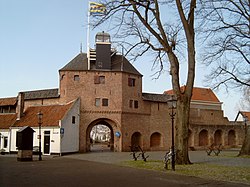Harderwijk
- Harderwijk is also a village in the Dutch municipality of Opmeer.
Harderwijk | |
|---|---|
Municipality | |
 City gate, Harderwijk | |
 | |
| Country | Netherlands |
| Province | Gelderland |
| Area (2006) | |
| • Total | 48.27 km2 (18.64 sq mi) |
| • Land | 38.46 km2 (14.85 sq mi) |
| • Water | 9.81 km2 (3.79 sq mi) |
| Population (1 January, 2007) | |
| • Total | 42,057 |
| • Density | 1,094/km2 (2,830/sq mi) |
| Source: CBS, Statline. | |
| Time zone | UTC+1 (CET) |
| • Summer (DST) | UTC+2 (CEST) |
ⓘ (Dutch Low Saxon: Harderwiek) is a municipality and a small city in the eastern Netherlands.
Population centres
- Harderwijk
- Hierden
The history of Harderwijk
Harderwijk received city rights from Count Otto II of Guelders in 1231.[1] A defensive wall surrounding the city was completed by the end of that century. The oldest part of the city is near where the streets Hoogstraat and Grote Poortstraat are today. Around 1315 the city was expanded southwards, which included the construction of what is now called the Grote Kerk (Large Church). A second, northward expansion took place around 1425. Particularly along the west side of town much of the wall still exists, although often not in entirely original form. This also goes for the only remaining city gate, the picturesque Vischpoort.
Between 1648 and 1811 the University of Harderwijk operated in the city. Carolus Linnaeus graduated at this university. The university, together with the universities of Zutphen and Franeker was abolished by Napoleon.
Harderwijk was a member of the Hanseatic League. It lies on what used to be the Zuider Zee shore (Southern Sea, now the IJsselmeer) and consequently its economy was strongly based on fishing and seafaring in general. This dramatically changed after 1932, when the Zuiderzee was cut off from the North Sea for safety reasons. Because of this, there are few fishing boats remaining in the harbour these days, which is now mainly home to yachts. An annual event illustrating the former importantance of the fishing industry to Harderwijk is Aaltjesdag, which translates to Eel day. Fish can still be bought at stands and restaurants on the boulevard throughout the year except for the winter months. Tourists are common customers, while local people no longer make their living from the fisheries.
Today, Harderwijk is probably known best for the Dolfinarium, a marine mammal park where dolphin shows are held and various other marine mammals and fish are kept.
-
Map Harderwijk (Blaeu's Toonneel der Steden, by Willem and Joan Blaeu, 1652.
-
Harderwijk, church: de Grote Kerk
-
Harderwijk, gate: de Vischpoort
-
Harderwijk, windmill
Veluwe
Harderwijk is on the western boundary of the Veluwe region and the southeastern half of the municipality consists largely of forests.
Transportation
Railway Station: Harderwijk
Born in Harderwijk
- Marco Roelofsen (1968), Dutch football (soccer) midfielder
- Richard Roelofsen (1969), Dutch football (soccer) striker
- Henk Schiffmacher (1952), tattoo artist
References
- ^ Stenvert, R. et al. (2000). Monumenten in Nederland: Gelderland, p. 50 and 183–188. Zwolle: Waanders Uitgevers. ISBN 90-400-9406-3
External links
- Official Website of Harderwijk
- Map of Harderwijk
- Dolfinarium Harderwijk (official website)









